Data available on the UNWTO’s dashboard indicates that the international tourist arrivals reduced by 74% in 2020 reaching the lowest levels in more than three decades. A recent UNCTAD report estimates a loss of $ 4 trillion to global GDP due to losses in the tourism sector.
Tourism is one of the worst affected sectors by the COVID-19 pandemic in almost every country. The imposition of measures like lockdowns, quarantines, travel restrictions, etc. by various countries to limit the spread of COVID-19 infection had an adverse impact on the tourism sector. The restrictions coupled with peoples’ general hesitance to travel in wake of the pandemic have further aggravated the situation.
This effect on tourism also had a cascading impact on other related sectors. The United Nations Conference on Trade and Development (UNCTAD) has released a study paper titled “COVID-19 & Tourism- An update: Assessing the Economic Consequences”. In this story, we review this paper as well as analyse the trends in international tourism and the impact of the pandemic.
74% decline in International Tourist arrivals in 2020 compared to 2019
As per the information available from United Nations World Tourism UNWTO’s Dashboard, the global inbound tourist arrivals were around 393 million in 2020. This was a drop of around 74% compared to 2019 when it was 1.46 billion. The global impact of COVID-19 on tourism was visible starting February 2020. The report states that if the pre-COVID-19 months, i.e., January & February 2020 are excluded, then the decline in the number of inbound tourist arrivals for the rest of 10 months in 2020 is around 84 %.
A slight recovery observed in July & August of 2020 after the first COVID-19 wave subsided in most countries. This was followed by a decline in the ensuing months, because of the emergence of the second wave of COVID-19 in many countries. However, the data from 2019 indicates that the number of inbound tourist arrivals during the latter half of 2019 was comparatively lower than the first half.
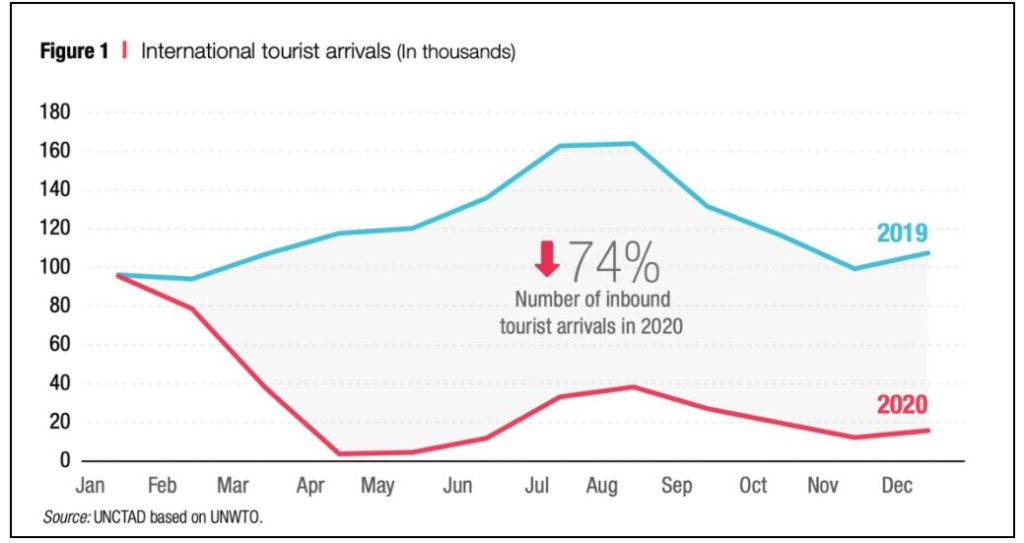
As per UNWTO, the number of international tourist arrivals in 2020 fell to the lowest levels in over three decades. One has to go back to 1987 when the number of international tourist arrivals was lower than the one reported in 2020.
The annual trend over the last decade indicates that since 2010, there has been consistent year-on-year growth in the number of global inbound tourist arrivals. Even since the year 2000, the number of global inbound tourist arrivals increased continuously except for a minor reduction in one or two instances. As per the report, even the beginning of 2021 has not been encouraging with an 88% average global decline compared to the pre-pandemic levels of 2020 (i.e., prior to March).
International Arrivals in the Asia-Pacific region fell by around 84% in 2020
UNCTAD’s report observes that compared to the developed countries, the developing countries bore the brunt of the impact on the tourism sector. It furthermore states that regions of Northeast Asia, Southeast Asia, Oceania, North Africa & South Asia are the most affected regions while North America, Western Europe & the Caribbean are the least effected. This is corroborated by the data available with UNWTO.
As per UNWTO’s dashboard, the international tourist arrivals in the Asia-Pacific region during 2020 were 57 million, an 84% decline compared to 2019. This is the highest proportional decline of all the regions. Asia-Pacific region includes 4 out of 5 areas (i.e., North-East Asia, South-East Asia, South Asia & Oceania) mentioned in UNCTAD’s report like the ones that were most affected.
In terms of volume, Europe witnessed a decline of over 510 million tourists in 2020 compared to 2019 i.e. a fall of over 69% while the tourist arrivals in the Americas fell by over 68%.
An estimated loss of nearly $ 4 trillion to the Global GDP in 2020-21 due to Tourism losses
As per a previous report by UNCTAD on COVID-19 and Tourism, a 12-month lockdown is estimated to cost around $ 3.3 trillion which includes direct and indirect costs. The latest report states that even the worst-case scenario has turned to be quite optimistic i.e., the actual loss could be more than the estimates.
The tourism sector as is the case with most other sectors is not stand-alone. There are backward and forward linkages between the sectors, which cause a cascading impact. The fall in international arrivals is going to affect other industries upstream – food, beverages, accommodation, transport, etc.
Labour and Capital as inputs to the tourism industry are also impacted due to decreased demand. The proportion of each of the inputs varies across the countries. However, it can be said that each of these inputs have been affected due to the fall in tourism.
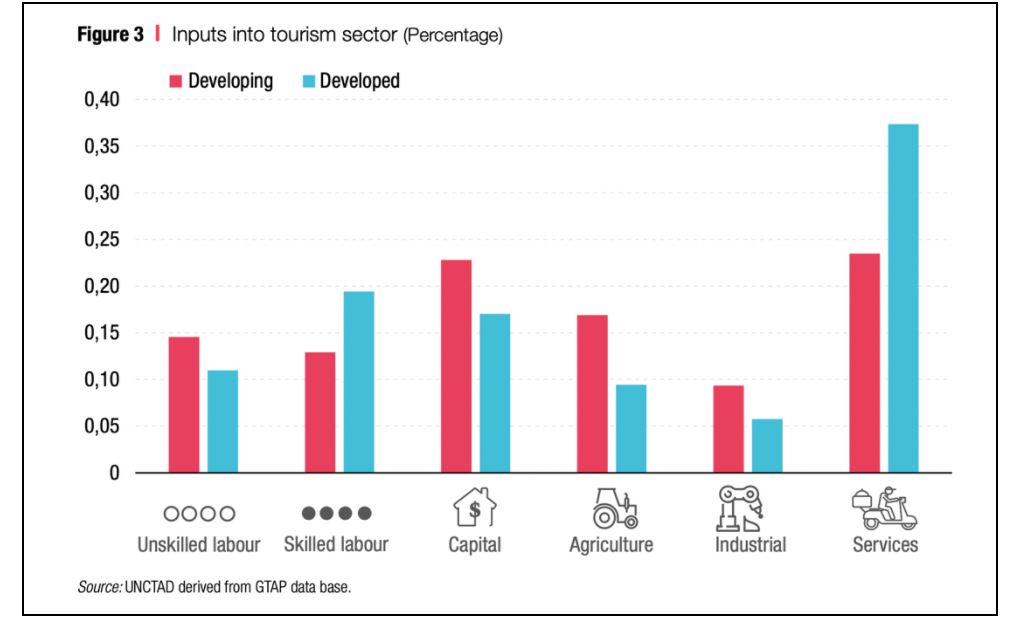
Computable General Equilibrium (CGE) modeling takes into consideration their intersectoral effects. Any reduction in the output of one sector can lead to a reduction in the inputs of other sectors. Therefore, the impact on the tourism sector will have an impact on other sectors related to tourism in turn impacting the GDP.
As per the analysis of UNCTAD, the fall in global tourist receipts will have a 2.5 times impact on the global real GDP. i.e., a drop by $ 1 trillion in global tourist receipts can lead to a loss of $ 2.5 trillion to the global real GDP.

However, this ratio varies from country to country based on their dependence on tourism. Compared to the developed countries, the developing countries have a higher dependency on Tourism. For example, it is estimated that Turkey will have an estimated loss of around 9% of its GDP due to the impact on its tourism.
The overall impact of COVID-19 on tourism is estimated to be around $ 4 trillion for 2020-21, taking into consideration even the indirect effects.
Countries with higher vaccination rates can cut down on the losses due to the Tourism industry by nearly half
In its estimates for 2021, the study has followed a 3-scenario approach. These three scenarios are in line with the projections of UNWTO for 2021.
First scenario: Continuation of the 74% decline in Tourist arrivals as observed in 2020. This varies between the countries, however, 74 % is taken as an average and is the most pessimistic scenario projected by UNWTO.
Second scenario: An optimistic approach for 2021, where the reduction in tourist arrivals falls only by 63 %.
Third scenario: Vaccination is considered as an influencing factor. Many of the countries have linked the opening of their borders & economy with their rate of vaccination. Since vaccination rates vary across countries, the report estimates a reduction in traffic arrivals by around 75% for low vaccinated countries and in the case of highly vaccinated countries, the loss can be cut down to as much as 37%.
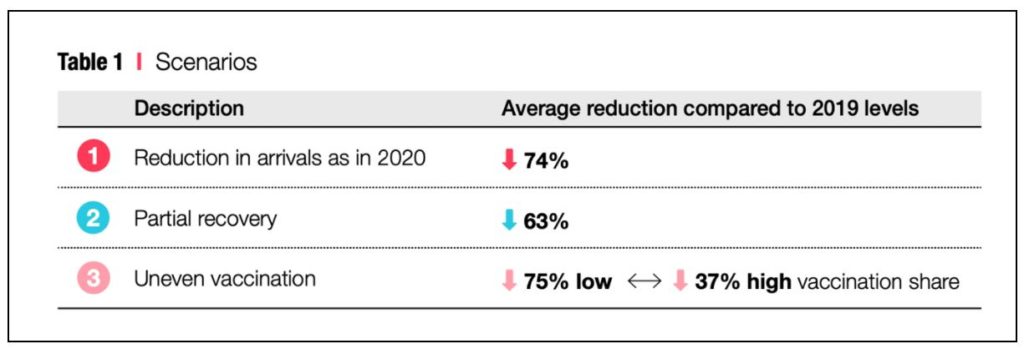
In accordance with the aforementioned CGE model, a standard GTAP Model (Global Trade Analysis Project) which takes into consideration the direct & indirect impacts on GDP, consumption, and employment in each of the 65 Goods & services sectors related to tourism sectors, etc. is used to arrive at the estimated impact on GDP due to the loss in tourism sector receipts globally.
The report uses these estimates to project the potential losses in there three different scenarios.
As per the most pessimistic estimate, there could be drop in Global tourist sales by $ 934 billion from the pre-pandemic numbers. Therefore, the total estimated blow to the GDP globally could be $ 2.4 trillion in 2021.
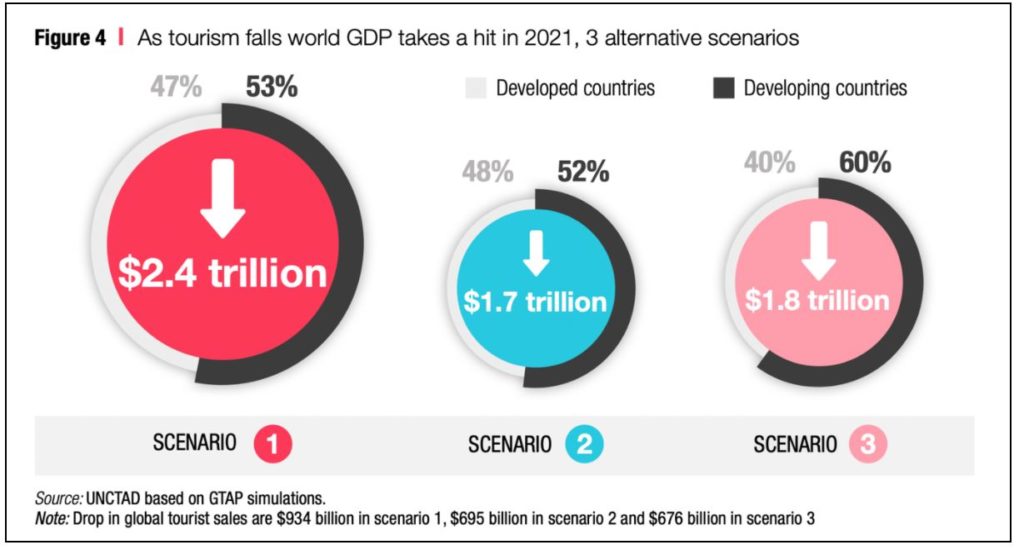
In a more optimistic scenario, the loss of $ 695 in billion in tourist sales is estimated, resulting in a loss of $ 1.7 trillion to GDP. The third scenario is highly variable depending on the vaccination status of the countries. Few of the more developed countries are ahead on the vaccination, while many of the developing countries are lagging behind. This becomes critical for many of the developing countries which are dependent on tourism. This includes countries like Turkey and many of the island nations.
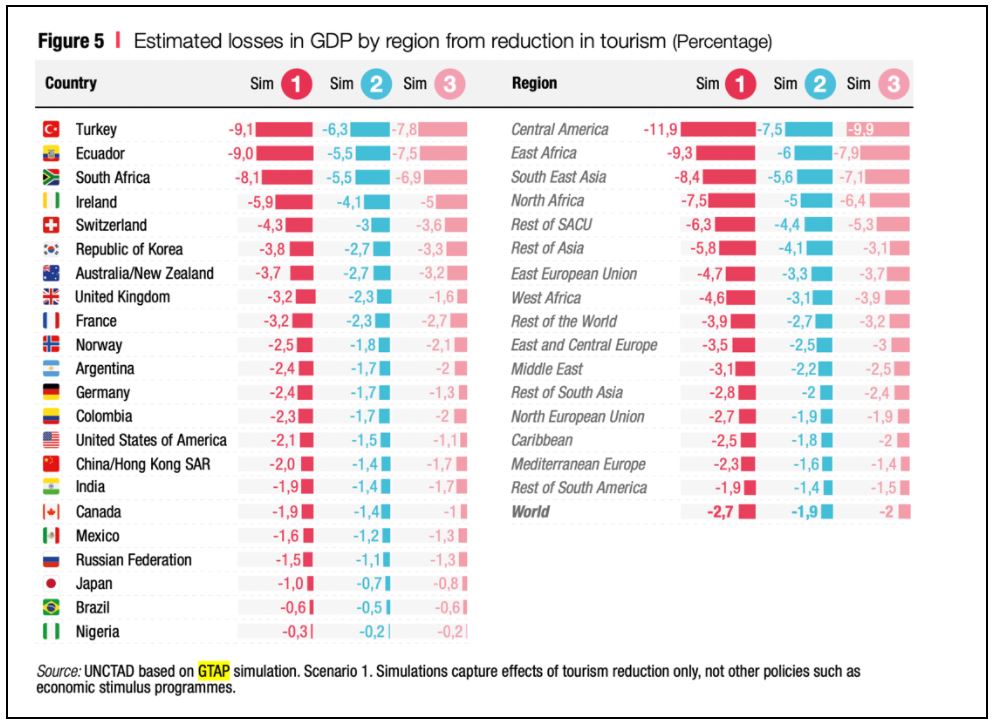
Vaccination, removal of travel restrictions important for improving the situation in the Tourism sector.
The report estimates that there are around 100-120 million jobs at stake in the tourism sector. The sector is one of the major economic boosters and forms a key part of the economy of many of the countries.
The losses in the tourism sector have resulted in an estimated loss of around $ 2.4 trillion in GDP in 2020 alone and there could be a similar situation even in 2021 if the restrictions are not relaxed and if the low vaccination rate persists in many countries.
The report suggests changes to the policy to be adopted by the countries to improve the tourism sector. These include Initiatives to encourage tourism, take action to mitigate the socio-economic impact on livelihoods & Strategic decisions to improve the future of the Tourism Industry in the respective countries.
The actionable items to bring these policies into effect largely depend on getting the respective populations vaccinated as soon as possible. Apart from Vaccination, removing the restrictions in travel and launching initiatives to encourage travel & tourists are other important actionable items to be undertaken by the countries to improve the sector.
Featured Image: COVID-19’s impact on Tourism


